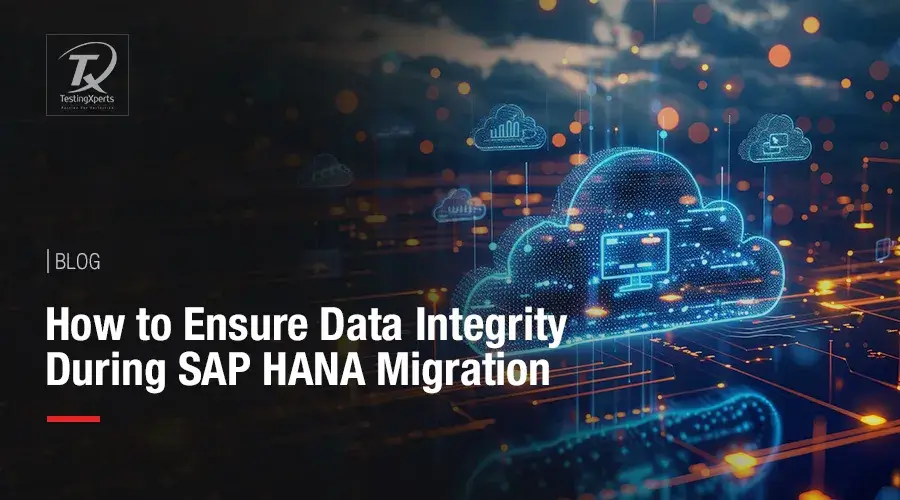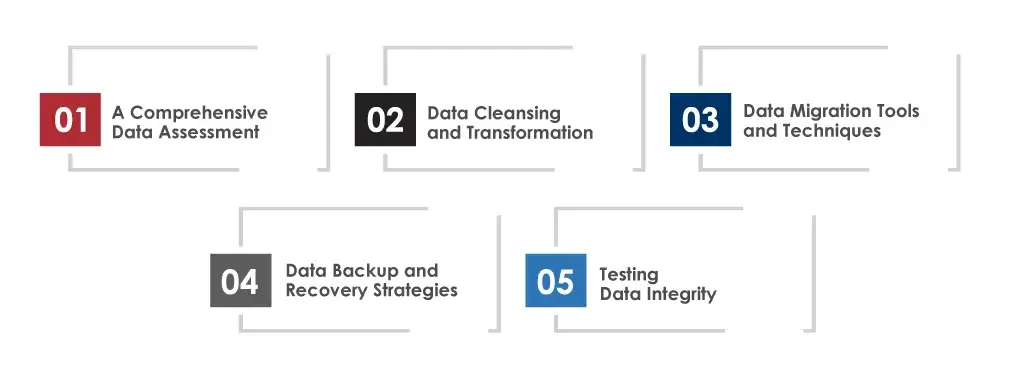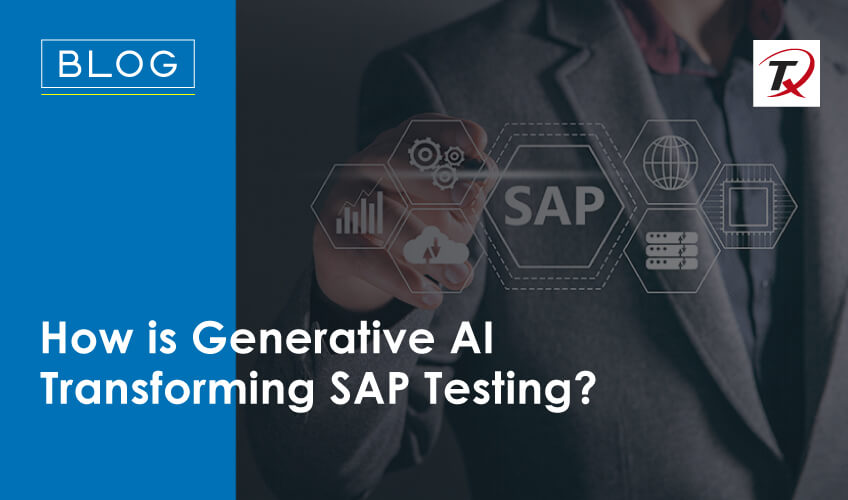
- What is SAP HANA, and Why is it Important?
- Features of SAP HANA
- Ensuring Data Integrity During SAP S/4 HANA Migration
- Why is Testing Necessary?
- How can Tx Ensure Your Data Integrity During SAP HANA Migration?
- Summary
Migrating to SAP HANA (high-performance analytical application) is a critical task for enterprises that involves moving sensitive business data to an upgraded and advanced ERP system. SAP ECC has been a top choice for many businesses for decades because of its variety of solutions that fulfill the unique requirements of organizations worldwide. Now, when SAP ECC is at the end of its cycle, organizations are switching or planning to switch to the next-gen EPR system, SAP S/4HANA. This migration would significantly change the current technology and data structures as it’s not a simple software upgrade.
One of the biggest hurdles during the migration process will be keeping data correct, protected, same, dependable, and ensuring data integrity. Moving data from old systems to SAP HANA will raise concerns over data quality and reliability, which requires proper surveillance, the right migration approach, and implementing testing strategies.
What is SAP HANA, and Why is it Important?
SAP HANA, or SAP S/4HANA, is a multi-model database that runs on Linux and stores data in memory instead of disk. This column-oriented database facilitates high-speed transactions and advanced analytics that run in a single system. One of the major highlights of this platform is that it can run on-premises, in the cloud, or in a hybrid cloud system. SAP HANA leverages and integrates data from multiple sources, such as:
- Emails, website forms, and other customer interactions
- Data from IoT-based sensors and devices
- Traditional business documents such as spreadsheets, deals, etc.
- Customers and workforce mobile devices
The platform compiles all this data and implements AI/ML algorithms to analyze it deeply and provide instant results. This helps in improving real-time decision-making by delivering key insights into business operations.
Why is SAP S/4HANA Important?

Enterprises have vast amounts of unused data in their data warehouses that offer no value. This data with untapped potential can be used to enhance business impact and offer better customer value. SAP HANA, powered by ML, offers real-time data analytics and lightning-fast in-memory processing. It utilizes organizational data to streamline business operations, offers benefits (to clients, employees, and customers), and eliminates errors. Transitioning to SAP HANA would offer various benefits, such as:
- Improved compliance and security
- Real-time reporting and analytics
- Optimized speed and performance
- Improved UX
- Data-driven business decisions
- Fast and agile response to market trends
- Streamlined business processes and data model
SAP S/4HANA Migration Timeline
Let’s take a quick look at the timeframe for SAP S/4HANA migration:
| Deadline for End of Support for SAP ECC | SAP will end its support service for ERP 6 EHP (6-8) by 2027 and for EHP (0-5) by 2025. Businesses should migrate to SAP HANA to leverage SAP support. |
| Database Vendor EOL Dates Impact | MS and Oracle might have varying EOL dates for SAP-supported databases. Organizations must keep track of the dates to avoid support service disruptions in SAP environments. |
| Migration and Support | The last date for SAP support is December 31, 2027. Businesses should plan their ERP database migration to SAP HANA to avoid service interruption and ensure continued support. |
Features of SAP HANA

SAP HANA analyzes real-time data to minimize data movements and improve app speed and agility. It can seamlessly process vast amounts of data and is highly scalable to meet the growing needs of the modern business ecosystem without degrading stability and security. Let’s take a quick look at some of the features of SAP S/4HANA that can benefit businesses in the long run:
Advanced-Data Management
In-memory technology is better than batch processing. It ensures that data is available with no latency and that all processes occur in real time. Businesses can streamline and upgrade their data management systems to improve work efficiency.
App Development
The software system that runs at the front end of the SAP HANA database works like a server for any web-based application, whether SAP or non-SAP. The server interacts with all types of files and exchanges data with the software, allowing businesses to develop and deploy customized processes and queries that benefit them.
Database Improvement
Databases are mainly organized around a single data model, which limits data organization, manipulation, and storage. SAP S/4HANA’s multi-model database supports multiple data models, making it easier for businesses to integrate data points.
Improved Analytics Processing
SAP HANA leverages ML algorithms to extract data from and write to the server in real time. This makes it possible to instantly access massive datasets from IoT sensors, mobiles, etc. Businesses can easily spot problems and design/implement solutions in every area of their operations, from HR portal to payroll to support.
Ensuring Data Integrity During SAP S/4 HANA Migration

Ensuring data correctness in SAP means keeping data true and ensuring it doesn’t change throughout the migration period. To ensure data integrity during the migration process, businesses should focus on the following things:
A Comprehensive Data Assessment
Companies should thoroughly review their existing data before migrating. They should identify the data sources, their type, how they are organized, and redundant or mismatched data.
Data Cleansing and Transformation
Once the issues are identified, one must implement the data cleansing and transformation techniques to keep data correct when shifting to SAP S/4HANA. Use automation tools and AI algorithms to ensure data is correct, high-quality, and ready to move to an upgraded ERP system.
Data Migration Tools and Techniques
When planning to migrate data, selecting the right tools, technologies, and techniques is a crucial step. This will facilitate easy data extraction, movement, and transformation (ETL processes). Using automated tools would allow businesses to prevent mistakes made with manual processes and ensure that data stays correct and secure during migration.
Data Backup and Recovery Strategies
Unexpected circumstances are bound to happen during the data transfer. Companies should have robust backup and recovery plans to recover data quickly and prevent process interruptions. They must have regular data backup and disaster recovery plans to prevent data loss and damage.
Testing Data Integrity
Partner with a professional QA expert to ensure data remains consistent and accurate throughout the SAP HANA migration process. Businesses can identify discrepancies, data loss, or corruption by executing data validation tests. Implementing automated tools and frameworks would help verify data integrity, ensuring it is in complete sync with the advanced ERP system.
Why is Testing Necessary?

Migrating to SAP S/4HANA involves moving critical business data to a new database structure. The process involves major challenges as SAP plays a major role in HR, supply chain, and finance. The risks may involve:
- Data inconsistencies
- Issues with business-critical functionalities supporting major processes
- System downtime issues
- Integration Challenge
This highlights the crucial role of comprehensive testing to ensure successful SAP HANA migration. However, one needs a reliable QA partner who can devise a seamless testing strategy that can assist them mitigate any hiccups during migration.
How can Tx Ensure Your Data Integrity During SAP HANA Migration?

Businesses rely heavily on SAP to support their operations and drive growth. At Tx, we offer tailored SAP testing services to address the unique challenges that might appear during the SAP platform’s implementation, including S/4HANA. From validating business processes to ensuring seamless alignment with existing IT infrastructure, our expert QA team has the tools and expertise to ensure data integrity during SAP HANA implementation.
Our experts deeply understand S/4HANA and conduct rigorous testing to check for performance, data integrity, and integration level with other systems. We verify that the new S/4HANA database functionalities align well with your business processes and meet the specifications across multiple modules. As a dedicated SAP testing expert, we offer personalized expertise and support throughout the testing cycle. Our QA experts work closely with clients to measure their unique business requirements and deliver customized testing solutions.
Summary
Ensuring data integrity during SAP HANA migration is crucial for businesses transitioning to this advanced ERP system. Migrating from SAP ECC to SAP S/4HANA presents challenges, particularly in maintaining data accuracy and consistency. Implementing robust backup and recovery strategies is also essential to prevent data loss. Testing is vital in this process, as it helps identify discrepancies and ensures data integrity throughout the migration. Partnering with a professional QA service like Tx can further ensure the success of SAP HANA migration by offering tailored solutions and ensuring that all business-critical functionalities are preserved. To know how Tx can help, contact our SAP testing experts now.
Discover more
Get in Touch
Stay Updated
Subscribe for more info


